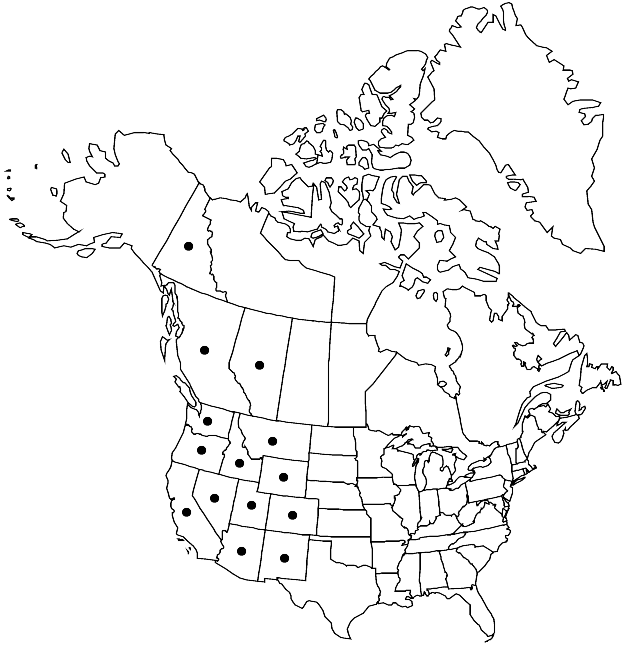Difference between revisions of "Descurainia incisa"
Mem. Torrey Bot. Club 5: 173. 1894.
FNA>Volume Importer |
FNA>Volume Importer |
Revision as of 20:24, 24 September 2019
Annuals; glandular or eglandular; densely to sparsely pubescent, glabrous or pubescent distally, sometimes canescent, trichomes dendritic. Stems erect, usually unbranched basally, branched distally or sometimes throughout, (1.3–)2–8.2(–10.7) dm. Basal leaves: petiole 0.5–4.7 cm; blade pinnate, obovate to oblanceolate in outline, 1.5–10.3 cm, lateral lobes (2–9 pairs), ovate or oblong to lanceolate or linear, margins usually dentate to incised or entire, rarely pinnatifid or crenate. Cauline leaves sessile or shortly petiolate; blade smaller distally, distal lobes oblong, lanceolate, linear, (margins dentate to denticulate or entire), surfaces pubescent or glabrous. Racemes considerably elongated in fruit, (glandular or eglandular). Fruiting pedicels ascending to divaricate or horizontal, straight, (3–)5–25(–30) mm. Flowers: sepals erect to ascending, yellowish, oblong to ovate, 1.6–2.4 mm, glabrous or pubescent; petals narrowly oblanceolate, 1.7–2.8 × 0.5–0.9 mm; median filaments 1.6–2.4 mm; anthers 0.3–0.4 mm. Fruits erect to ascending, linear, slightly torulose, 8–20 × 0.9–1.3 mm, (straight or slightly to strongly curved inward); valves each not veined or with distinct midvein; septum not veined; ovules 14–26 per ovary; style 0.1–0.3 mm, glabrous. Seeds uniseriate, reddish brown, oblong, 0.9–1.3 × 0.5–0.6 mm.
Distribution

North America, n Mexico.
Discussion
Subspecies 2 (2 in the flora).
As delimited by various authors and as represented in all major herbaria consulted, Descurainia incisa is highly variable in almost all features. The variation is most likely the result of hybridization with all species of the genus that have overlapping ranges. Forms with few-seeded, short fruits tapering at both ends most likely represent hybrids with D. californica; those with sub-biseriate seeds most likely resulted from crossing with D. pinnata, and the origin of forms with somewhat subappressed fruits almost certainly involved D. incana. The recognition of glandular versus eglandular forms as distinct varieties or subspecies is completely artificial. The lectotype (Fendler 29, GH) and isolectotype (MO) are eglandular; a syntype (Fendler 31, MO) is densely glandular.
Selected References
None.
Key
| 1 | Fruiting pedicels ascending to divaricate, (3-) 5-10(-12) mm; lateral lobes of basal and proximal cauline blades (3-)5-9 pairs, margins usually coarsely dentate to incised, rarely crenate or pinnatifid; lobes of distal cauline blades oblong to lanceolate, margins dentate to denticulate; fruits straight or curved inward. | Descurainia incisa subsp. incisa |
| 1 | Fruiting pedicels horizontal to divaricate, (10-) 13-25(-30) mm; lateral lobes of basal and proximal cauline blades 2 or 3 (or 4) pairs, margins usually entire; lobes of distal cauline blades linear, margins entire; fruits curved inward. | Descurainia incisa subsp. paysonii |